Restoring Access Throughout the Tennessee River System
Professional Dredging Services for Scottsboro Riverfronts & Reservoirs
-
Tennessee River & Tributary Expertise
-
TVA Drawdown & Silt Management
-
Riverbank & Backwater Channel Repair
-
Serving the Tennessee Valley Region
In this river-driven part of The River State, water access is key to life. The Tennessee River system, from Guntersville to Wheeler and Pickwick, shapes North Alabama's economy and lifestyle. We specialize in dealing with the unique silt, river flow, and seasonal drawdown challenges specific to the Tennessee Valley. Whether you need your marina dredged or a backwater channel cleared, we bring local knowledge to maintain river communities of North Alabama.
Why Scottsboro River Communities Choose Us
In North Alabama, life revolves around the Tennessee River. Our team understands the specific conditions of The Tennessee Valley—how silt moves with the river flow, how tailwater affects backwater coves, and the erosion caused by this region's clay in the watershed systems. We're the local experts who know this river, the foothills terrain, and the TVA timing required to do the job right.
Expertise in The Tennessee Valley
- Specialized experience with the Tennessee River's current and flow dynamics
- Intimate knowledge of all major TVA-managed waterways
- Familiar with the unique silt and sediment movement in North Alabama
TVA & Water Level Compliance
- Strict adherence to TVA seasonal drawdown schedules
- Permitting expertise for work on TVA reservoirs (Guntersville, Wheeler, etc.)
- Precision dredging during periods of low water or specific flow conditions
Tailwater & Tributary Management
- Specialist equipment for shallow tributary creeks and backwater channels
- Managing silt and clay runoff from the surrounding ridge-and-valley terrain
- Restoring depth to river-fed coves and sloughs for year-round access
Riverfront Erosion Solutions
- Targeted repairs for riverbank erosion and washouts
- Stabilization of shoreline areas affected by river current and boat wake
- Drainage and stormwater solutions tied into river systems
Generational River Properties
- Respect for family cabins, camps, and heritage properties along the river
- Commitment to restoring river access for future generations
- Serving the residential river communities of North Alabama
Straight Talk for North Alabama
- Honest assessment of dredging and river access needs
- Transparent pricing that respects the Tennessee Valley budget
- Focus on environmental responsibility in this delicate watershed
Specialized Dredging Services for Alabama

Mechanical Excavation Dredging
Ideal for coves on Lake Martin, Lay Lake, and neighborhood ponds across Alabama suburbs. We use sectional barges for precision sediment removal in smaller HOA lakes, handling heavy red clay and dense debris found throughout central and north Alabama.
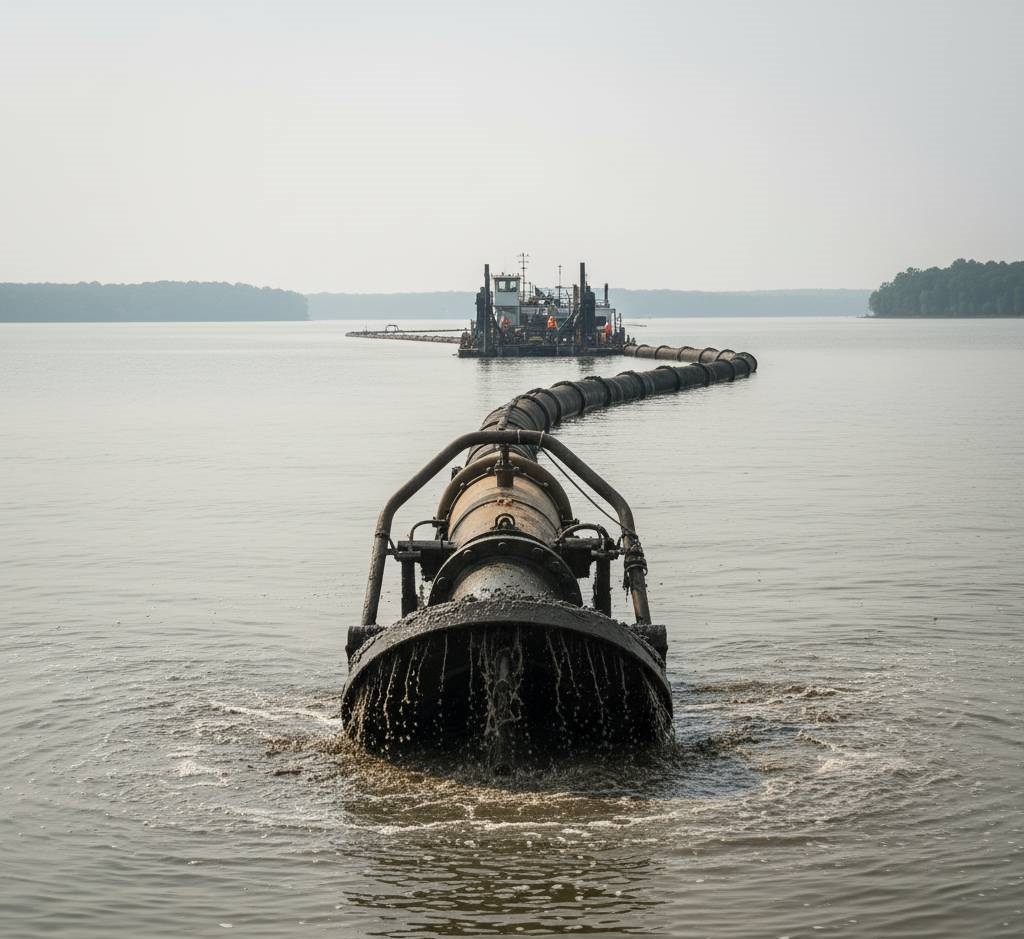
Hydraulic Pumping Systems
Best for large-scale operations on major water bodies such as Guntersville Lake, Wheeler Reservoir, and the Tennessee River system. Our equipment can pump fine silt and muck over long distances to remote dewatering sites, ideal for TVA reservoirs.
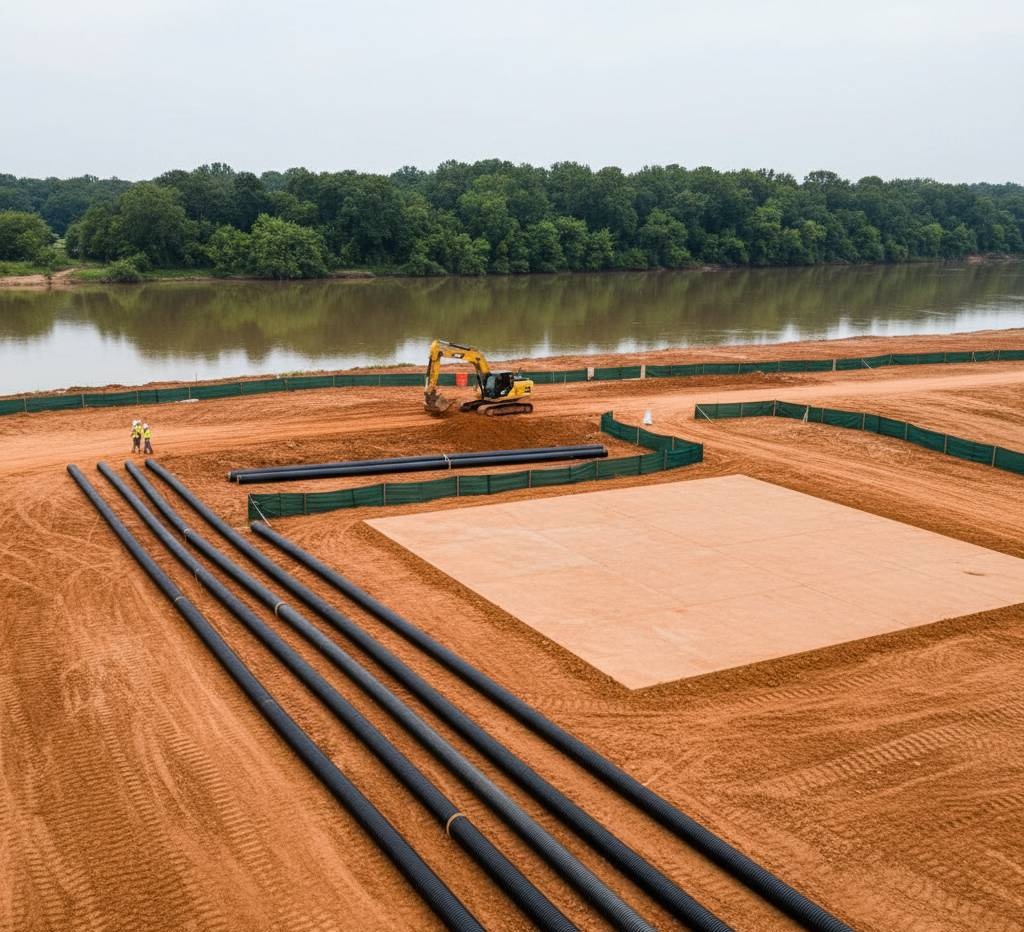
Integrated Sediment Management
A comprehensive approach ensuring compliance with ADEM regulations. This includes on-site dewatering using methods suitable for Alabama's diverse soils (from Tennessee Valley clay to Gulf Coast sand) with approved disposal or beneficial reuse planning.
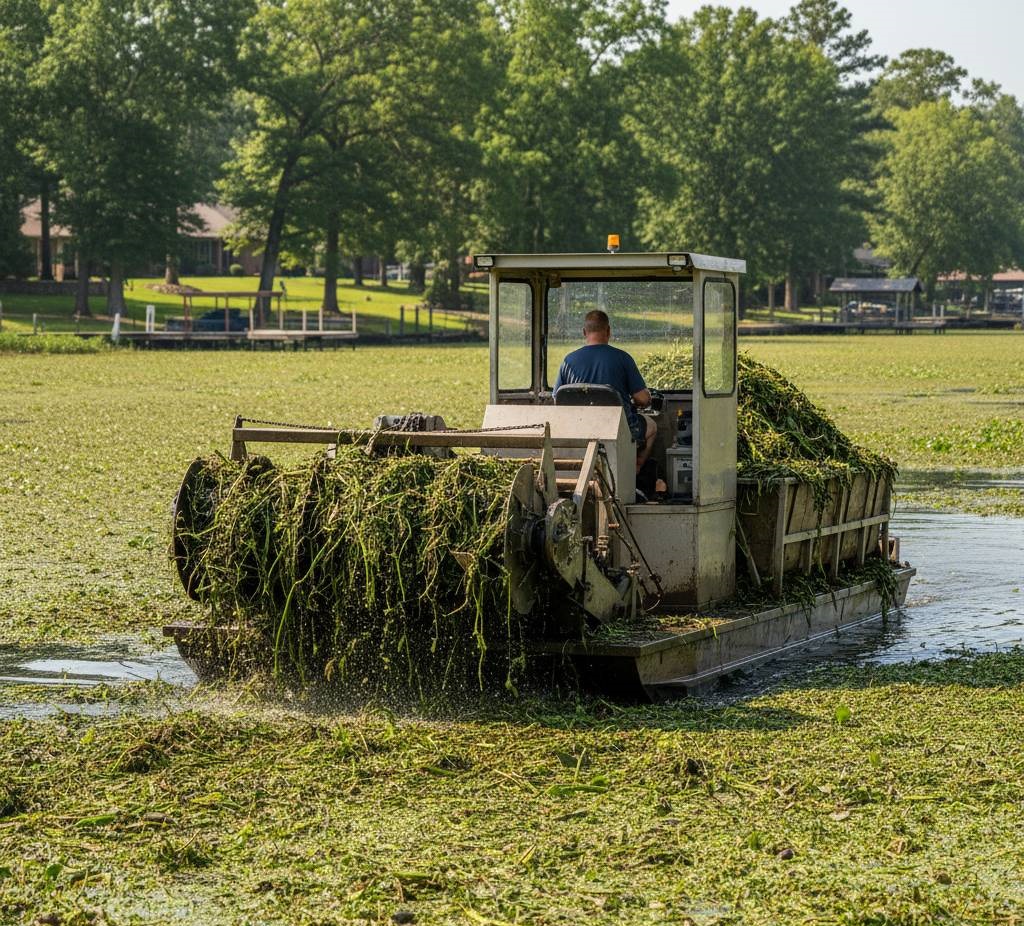
Aquatic Growth Control
Targeted removal of aggressive Alabama aquatic weeds—like hydrilla, water hyacinth, and milfoil—to combat the effects of shallow water and nutrient-rich sediment that cause severe weed infestations in our warm southern climate.
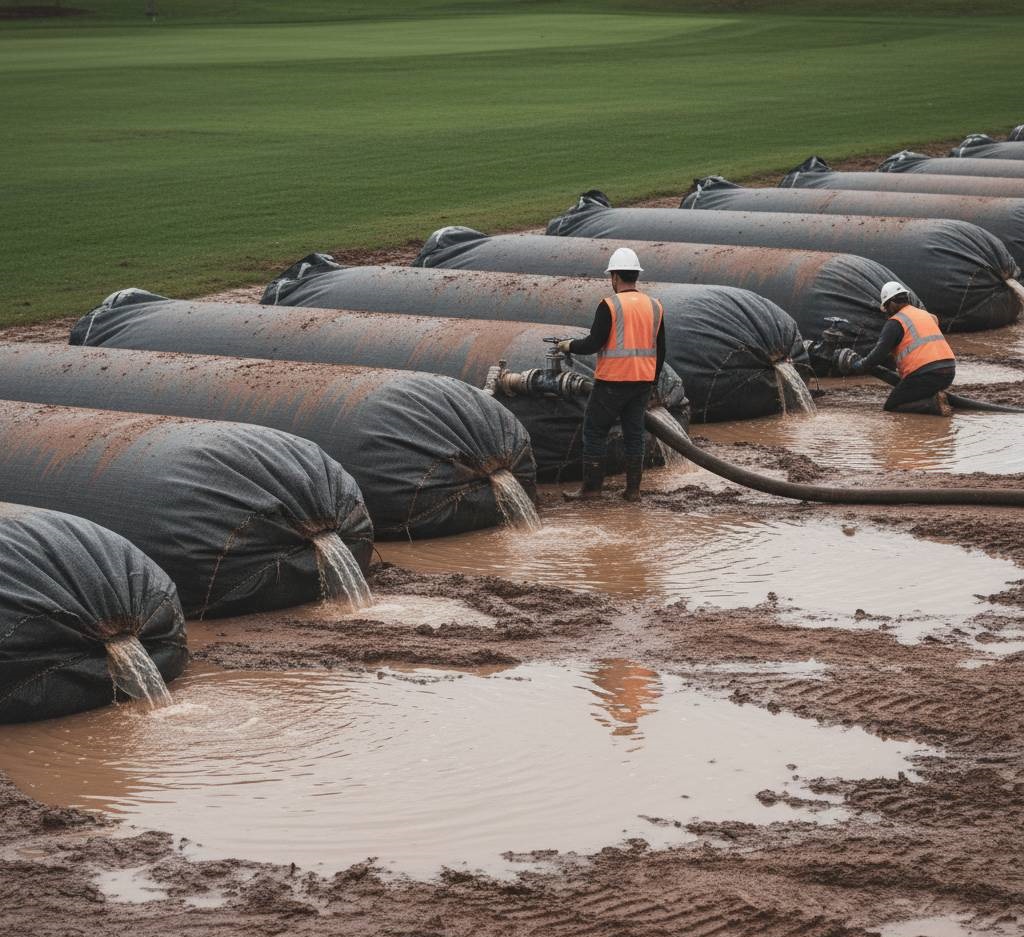
Advanced Dewatering Techniques
Installation and management of Geotextile tubes for efficient dewatering on HOAs, golf courses, and properties across Alabama. We also design and manage upland pad drying operations where available land permits, with special consideration for red clay disposal.
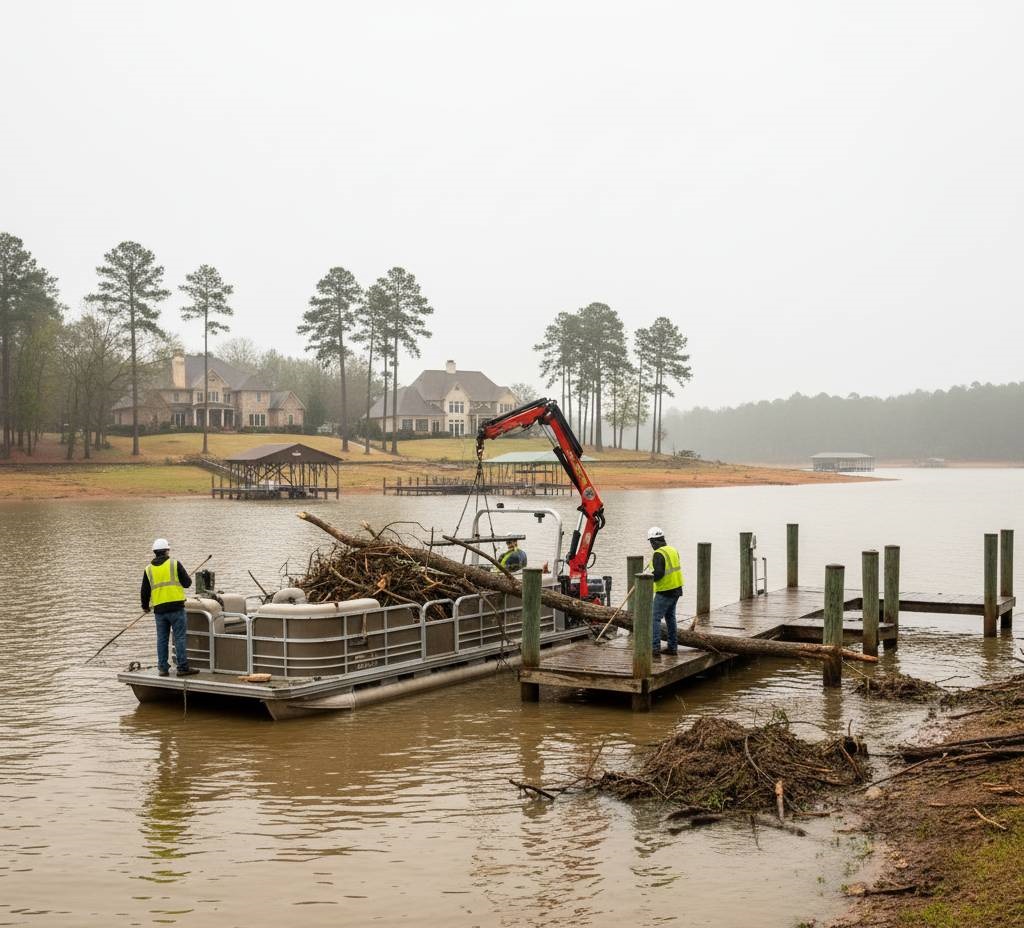
Waterway Maintenance Programs
Post-event cleanup and maintenance after major storms or TVA drawdowns. We offer season-based lake management programs to prevent sediment re-accumulation, particularly important during Alabama's hurricane season and seasonal water level adjustments.
Let's Talk About Your Scottsboro Lake
Whether you're dealing with red clay sediment buildup, losing dock access, or just noticing your lake isn't as deep as it used to be, we can help. We'll come out, take a look, and give you straight answers about what needs doing and what it'll cost. No pressure, no sales pitch—just honest advice from folks who know Alabama lakes.
Common Questions from Scottsboro Riverfront Owners
Real answers about dredging the Tennessee Valley's major reservoirs, tributaries, and river channels
Do I need permits to dredge my Scottsboro lake?
Yes, absolutely. In North Alabama, most work on the Tennessee River and its major tributaries requires approval from TVA (Tennessee Valley Authority) and the U.S. Army Corps of Engineers, in addition to ADEM. TVA sets the rules for water level, dock placement, and sediment removal on all their reservoirs (Guntersville, Wheeler, etc.).
Dealing with the TVA can be complex, but we manage the entire permitting process, ensuring compliance with both federal and state regulations. We know the necessary steps to get your project approved, whether it’s a main channel marina or a secluded backwater cove.
What's the deal with Alabama's red clay sediment?
The sediment challenge in The Tennessee Valley is unique: a mix of silt carried by the main river current and heavier clay/mud washing down from the surrounding foothills and small creeks. The fast flow of the Tennessee River keeps the main channel clear, but silt quickly settles in protected backwater areas, sloughs, and riverfront marinas.
This accumulation of silt and clay greatly reduces depth during seasonal drawdowns. We use specialized equipment designed to cut through the compacted silt beds common in Northern Alabama and restore the water depth you need for dock and boat access.
Where does the dredged sediment go?
The dredged silt and clay can be hauled to an approved disposal site, or, in many cases, it is kept on-site for beneficial reuse. This is often used for stabilizing eroded sections of riverbank or building up low-lying land in flood-prone areas along the river communities of North Alabama.
We handle the dewatering process—often using geotextile tubes—to separate water from solids. Once stable, the material can be shaped for shoreline protection or erosion control, ensuring we minimize environmental impact while maximizing the utility of the excavated material.
What type of dredging is best for my Scottsboro property?
It depends on the specific location on the Tennessee River. For deep silt accumulation in open areas, hydraulic systems are efficient for long water runs. For hard-packed clay, debris, or tight marinas in a tributary, we typically use mechanical methods from a barge or bank access.
We also account for factors like the tailwater effects below a dam, the strength of the river current, and access along the riverbank from the foothills terrain. We'll assess these unique North Alabama conditions to recommend the safest and most cost-effective method for your specific riverfront property.
How much does lake dredging cost around Scottsboro?
Costs generally fall between $25-$90 per cubic yard, but the complexity of dredging in The Tennessee Valley often affects the final price. Factors include sediment type (silt versus clay), proximity to the river's main channel, disposal method, and, critically, ease of riverbank access for heavy machinery.
We provide clear, detailed quotes that account for specialized TVA permitting fees and the logistical challenges of working in this region. Our goal is transparent pricing for North Alabama property owners, ensuring you know the full cost before the work begins.
When's the best time to dredge in Alabama?
The ideal time in the Tennessee Valley is typically during the TVA's winter drawdown period—from October/November through March/April—when the water levels are at their seasonal low. Working with the low water allows us maximum visibility and minimizes the impact of strong river flow or current.
Scheduling during the cooler, drier months helps us avoid summer recreation traffic and high-flow events. If you're near a tributary or creek, we schedule to avoid heavy spring rains when those waterways are moving the most sediment.
How long will my Scottsboro dredging project take?
Project duration varies. A small boat dock area might be a week. Clearing a large marina or restoring a long backwater channel in North Alabama can take 4-8 weeks, depending on volume and sediment composition. Permitting for TVA reservoirs can add additional time upfront, which we manage diligently.
Our schedules are built around the TVA timing and the weather patterns of this region of The River State. We keep constant communication to ensure we meet your goal of restoring depth before the summer boating season or the next high-water period.
Will dredging hurt the fishing in my lake?
Dredging is essential for long-term river habitat health. By removing excess silt, we restore the deep, clear areas that Tennessee River fish—like bass, crappie, and catfish—depend on for survival, especially during winter and hot summers. We work carefully to minimize turbidity and protect the river life.
The Tennessee Valley is known as the Bass Capital, and our work supports that reputation by clearing key boat channels and restoring depths in river-fed sloughs and fishing coves. Once sediment clarity is restored, the fishing often improves dramatically.
Alabama Dredging Service Regions
We provide comprehensive dredging solutions across Alabama's diverse waterways, from the Tennessee Valley to the Gulf Coast, each with unique water management challenges and opportunities.
1. Central Alabama (Greater Birmingham + West AL + River Region)
The heart of Alabama, where the Magic City metro blends with suburban lake living, West Alabama's rich traditions, and the historic River Region. This corridor revolves around the Cahaba, Coosa, and Black Warrior Rivers, with popular waters like Lay Lake, Lake Jordan, and Lake Tuscaloosa shaping daily lake life. Here, Roll Tide and War Eagle fans live side by side along river-fed neighborhoods and community lakes.
Key AL Locations:
2. North Alabama (Tennessee Valley)
Defined by the Tennessee River and its TVA-managed reservoirs, North Alabama balances flowing river systems with backwater coves, tributaries, and sloughs. Work here focuses on keeping deep-water access, managing silt in current-affected areas, and addressing red clay and fine sediment that move with seasonal drawdowns and heavy rains.
Key AL Locations:
3. East Alabama – Auburn-Opelika & the Chattahoochee–Tallapoosa River Region
Where river systems and lake life meet. Anchored by the Auburn-Opelika corridor, East Alabama is shaped by the Chattahoochee and Tallapoosa Rivers with major regional waters like Lake Martin and Lake Harding, plus river-fed lakes along the Coosa chain (including Logan Martin and Neely Henry). Our work balances river current, watershed inflows, and red clay sediment that settles into coves, community lakes, and stormwater systems.
Key AL Locations:
4. The Wiregrass (Southeast AL)
A rural, agricultural landscape where ponds and warm-water rivers drive daily water management. The Wiregrass features the Choctawhatchee and Pea River watersheds, extensive farm and irrigation ponds, and subdivision retention systems. Projects focus on weed and algae control, sediment removal after heavy rains, and practical restoration for working properties and neighborhoods.
Key AL Locations:
5. Gulf Coast / Lower Alabama (LA)
Where The River State meets the coast. Mobile Bay, the Mobile–Tensaw Delta, and the Intracoastal Waterway define this coastal system, with tidal influence, brackish conditions, and storm-driven sediment movement. Canal maintenance, marina access, and post-storm recovery are core needs alongside year-round waterfront living and tourism.
Key AL Locations:
If you don't see your area listed, reach out — we frequently take on projects across rural lakes, private ponds, and unique waterfront properties throughout Alabama.